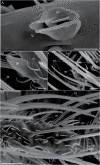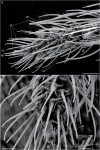Morphological Characterization of the Antennal Sensilla of the Afrotropical Sand Fly, Phlebotomus duboscqi (Diptera: Psychodidae)
- PMID: 33710316
- PMCID: PMC8243367
- DOI: 10.1093/jme/tjaa247
Morphological Characterization of the Antennal Sensilla of the Afrotropical Sand Fly, Phlebotomus duboscqi (Diptera: Psychodidae)
Erratum in
-
Corrigendum to: Morphological Characterization of the Antennal Sensilla of the Afrotropical Sand Fly, Phlebotomus duboscqi (Diptera: Psychodidae).J Med Entomol. 2022 Jan 12;59(1):400. doi: 10.1093/jme/tjab185. J Med Entomol. 2022. PMID: 34750624 Free PMC article. No abstract available.
Abstract
We investigated by scanning electron microscopy the morphology, distribution, and abundance of antennal sensilla of females Phlebotomus duboscqi sand fly, an important vector of zoonotic cutaneous leishmaniasis at Afrotropical region. Thirteen well-differentiated sensilla were identified, among six types of cuticular sensilla. The probable function of these sensillary types is discussed in relation to their external structure and distribution. Five sensillary types were classified as olfactory sensilla, as they have specific morphological characters of sensilla with this function. Number and distribution of sensilla significantly differed between antennal segments. The results of the present work, besides corroborating in the expansion of the morphological and ultrastructural knowledge of P. duboscqi, can foment future electrophysiological studies for the development of volatile semiochemicals, to be used as attractants in traps for monitoring and selective vector control of this sand fly.
Keywords: Leishmania major; Phlebotominae; antenna; sand fly; ultrastructure.
© The Author(s) 2020. Published by Oxford University Press on behalf of Entomological Society of America. All rights reserved. For permissions, please e-mail: journals.permissions@oup.com.
Figures






References
-
- Altner, H., and Prillinger L.. 1980. Ultrastructure of invertebrate chemo-, thermo-, and hygroreceptors and its functional significance. Int. Rev. Cytol. 67: 69–139.
-
- (AFPMB) Armed Forces Pest Management Board . 2015. Sand flies – significance, surveillance, and control in contingency operations. Technical Guide No. 49. Armed Forces Pest Management Board, US Army Garrison, Silver Spring, MD. 65 p.
-
- Bahia, A. C., Secundino N. F., Miranda J. C., Prates D. B., Souza A. P., Fernandes F. F., Barral A., and Pimenta P. F.. 2007. Ultrastructural comparison of external morphology of immature stages of Lutzomyia (Nyssomyia) intermedia and Lutzomyia (Nyssomyia) whitmani (Diptera: Psychodidae), vectors of cutaneous leishmaniasis, by scanning electron microscopy. J. Med. Entomol. 44: 903–914. - PubMed
-
- Bray, D. P., Ward R. D., James A., and Hamilton G. C.. 2010. The chemical ecology of sandflies, pp. 203–215. InTakken W. and Knols B. G. J.. (eds.), Olfaction in vector-host interactions: ecology and control of vector-borne diseases, vol. 2. Wageningen Academic Publishers, Wageningen, The Netherlands.
-
- Cate, H. S., and Derby C. D.. 2002. Hooded sensilla homologues: structural variations of a widely distributed bimodal chemomechanosensillum. J. Comp. Neurol. 444: 345–357. - PubMed
Publication types
MeSH terms
LinkOut - more resources
Full Text Sources

